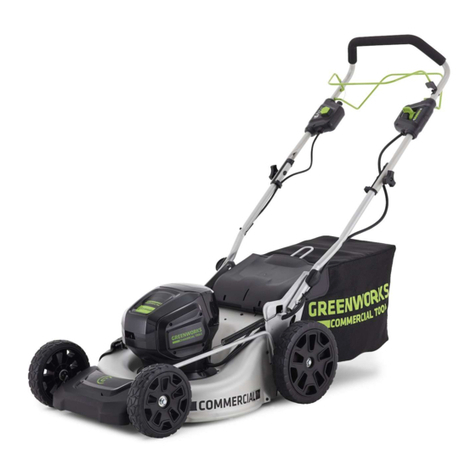
1 Description...................................3
1.1 General information....................................3
1.2 Overview.................................................... 4
2 General machine safety
warnings.......................................4
2.1 Work area safety........................................ 5
2.2 Electrical safety.......................................... 5
2.3 Personal safety...........................................5
2.4 Machine use and care................................ 5
2.5 Battery tool use and care........................... 6
2.6 Service....................................................... 6
3 Lawn mower safety warnings.... 6
4 Safe practices for stand-on
mowers.........................................7
4.1 General information....................................7
4.2 Preparation before operating......................7
4.3 Operating....................................................7
4.4 Children specific......................................... 7
4.5 Slope specific............................................. 8
4.6 Hauling....................................................... 8
4.7 Towing........................................................ 8
4.8 Service....................................................... 8
5 Symbols on the product............. 8
6 Risk levels..................................10
7 Environmentally safe battery
disposal...................................... 11
8 Proposition 65............................11
9 Know your machine.................. 12
9.1 Control panel............................................ 12
9.2 Steering control levers..............................12
9.3 Safety start interlock system.................... 12
9.4 Electric take off (ETO) socket for
connecting accessories............................ 13
10 Operation................................... 13
10.1 Before operation.......................................13
10.2 Operate the machine................................13
10.3 Slope operation........................................ 15
11 Operation suggestions............. 15
12 Electrical system....................... 17
12.1 Electrical system safety............................17
12.2 Electrical system information....................17
12.3 Battery and charger..................................17
12.4 Digital display........................................... 18
13 App operation tips.....................22
13.1 Registration and Login............................. 22
14 Errors..........................................23
14.1 Display screen error code........................ 23
14.2 BMS Error code........................................24
14.3 Battery charger error code....................... 27
14.4 Right wheel motor controller error code... 28
14.5 Left wheel motor controller error code......35
14.6 Left blade motor controller error code...... 41
14.7 Middle blade motor controller error code..43
14.8 Right blade motor controller error code....45
15 Maintenance...............................46
15.1 Mower blade maintenance....................... 46
15.2 Tires..........................................................46
15.3 Torque values........................................... 47
15.4 Battery pack maintenance........................47
15.5 Service..................................................... 47
16 Transportation and storage......48
16.1 Transporting the lithium-Ion batteries....... 48
16.2 Transporting the machine.........................48
16.3 Cleaning and storage............................... 49
17 Troubleshooting........................ 50
18 Technical data............................50
19 Limited warranty........................51
19.1 What is covered by this warranty............. 51
19.2 Who must perform the warranty service...51
19.3 What is not covered by this warranty....... 51
19.4 Disclaimer of warranty..............................52
19.5 Limitation of remedies.............................. 52
19.6 Time limit.................................................. 52
19.7 No other warranties.................................. 52
19.8 Owner's responsibility...............................52
19.9 Allocation of risks..................................... 53
19.10Warranty registration................................ 53
1
English EN


































